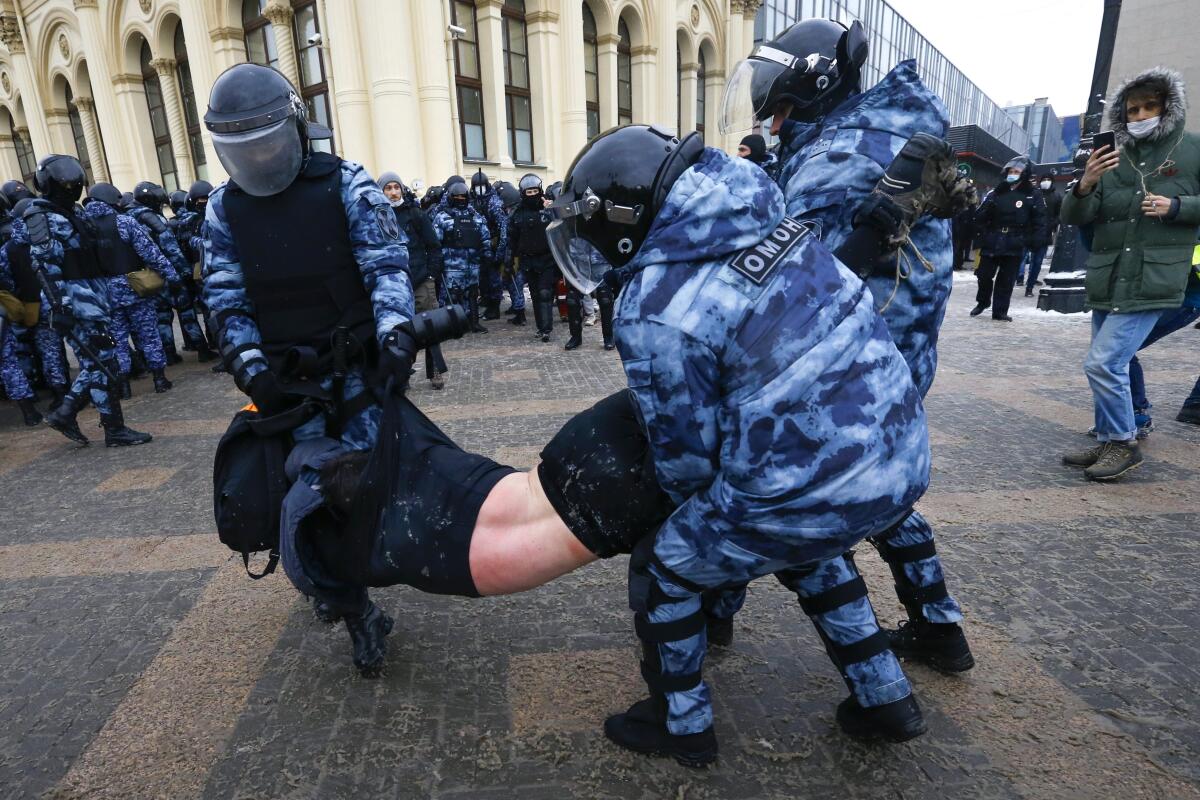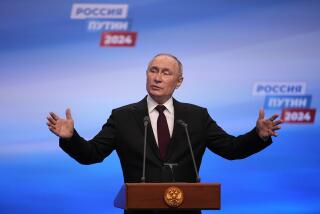How Russia has tried to stem pro-Navalny protests

- Share via
MOSCOW — A prison sentence for Russian opposition leader Alexei Navalny and a sweeping crackdown on protesters demanding his release reflect the Kremlin’s steely determination to fend off threats to its political monopoly at any cost.
Russia has seen mass protests before, of course — and it has used various tactics to confront them, ranging from offering concessions to violently cracking down. The current wave of demonstrations, however, has spread across Russia’s 11 time zones, a marked difference from the past, when crowds were mostly limited to Moscow. Tens of thousands of people have taken to the streets in recent weekends in the largest and most extensive outpouring of anger against President Vladimir Putin’s rule in years.
The Associated Press examined Russian authorities’ no-holds-barred response to the latest protests.
TOUGH LAWS
All demonstrations are currently prohibited in Russia as part of coronavirus restrictions, giving authorities wide latitude to crack down, but the government is also making broad use of laws put in place after 2011-12 anti-Kremlin protests. Those measures made taking part in unsanctioned rallies punishable by heavy fines and prison terms even if they remain peaceful.
In addition, the Kremlin has also introduced laws that have sought to stifle foreign-funded nongovernmental organizations, including those that have highlighted human rights abuses that the Kremlin wants to keep quiet. Any NGO that receives such funding and engages in what is vaguely described as political activities must register as a “foreign agent,” a label that carries heavy stigma in Russia, where it sounds synonymous with a spy.
That, along with mounds of new paperwork, made their work more difficult — and make it more challenging for them to document human rights abuses.
NAVALNY’S TEAM TARGETED
Navalny was jailed immediately after his Jan. 17 return from Germany — where he had spent five months recovering from the nerve-agent poisoning he blames on the Kremlin. Since then, authorities have moved swiftly to silence and isolate his allies.
Last week, a Moscow court put his brother Oleg, top associate Lyubov Sobol and several other key allies under house arrest — without access to the internet — for two months as part of a criminal probe into alleged violations of coronavirus regulations during protests. In regions all across Russia, top members of Navalny’s team also faced arrests.
Despite these moves, associates of Navalny who remain free have used social media to organize the protests, designating assembly points and routes of marches and posting advice on how to bypass police cordons and avoid detention.
POLICE TACTICS
During the Jan. 31 protest in Moscow, authorities imposed an unprecedented lockdown of the city center, closing large swaths to pedestrian traffic, shutting several subway stations and closing restaurants and stores.
The shutdown was aimed at preventing demonstrators from rallying near the main headquarters of the Federal Security Service and other government buildings.
Police also moved to prevent massive gatherings at any specific location — an apparent effort to obscure the size of protests and thus the opposition’s strength.
Police used security cordons to force protesters to zigzag around the city and then sought to break them into smaller groups before moving to arrest them. The random pattern of arrests — with police caught on video chasing down lone protesters at times — served to scare the public and discourage people from joining the rallies.
Police treatment of peaceful protesters has also become increasingly brutal, with officers beating even those who offered no resistance and using electroshock weapons against some.
On one occasion, a dozen riot police officers blocked a taxi after its passenger yelled at them, grabbing the man and beating him and detaining the driver.
INTIMIDATION AND THREATS
Russian law enforcement agencies have tried to discourage people from joining protests by warning that if the rallies turn violent, participants could face prison sentences of up to eight years and those who engage in violence could end up with 15-year sentences.
Authorities also demanded that social platforms block calls for protests and threatened them with fines and potential closure if they fail to obey. Some Russia-owned social networks appeared to at least partly comply with the demand.
In various regions of Russia, high schools and universities reportedly sought to prevent students from joining the protests by threatening them with expulsion. In Moscow and other cities across the country, some teachers lost their jobs after attending rallies.
In addition, the Investigative Committee, the top state investigative agency, said it would check if anyone detained at a protest is subject to the draft. While Russia has compulsory military service, many manage to avoid the unpopular draft through various deferments.
MEDIA SPIN
Television networks and other state-controlled media have toed the Kremlin line, portraying Navalny as a power-hungry Western stooge.
The state media have sought to cast protesters as spoiled urbanites, out of touch with the masses, and focused on occasional scuffles to claim that the demonstrators engage in violence and provoke the police. They also sought to characterize the police response to rallies — including their avoidance of tear gas, water cannons and stun grenades — as less violent than what authorities in the West have done.
MASS DETENTIONS
Police detained about 4,000 protesters across Russia on Jan. 23 and more than 5,750 on Sunday, according to the OVD-Info group that is monitoring arrests — the largest number of detentions since Putin was first elected in 2000. During the demonstrations after Navalny’s sentencing Tuesday, they made more than 1,400 arrests, nearly 1,200 of them in Moscow.
The number of detainees was so high that detention facilities in Moscow ran out of space, and many arrested protesters spent long hours on police buses as the authorities tried to find accommodations for them.
Most of those detained were released after being handed court summons — but they faced fines and jail terms ranging from seven to 15 days. A few dozen accused of violence against police have faced criminal charges that could land them in prison for years.
More to Read
Sign up for Essential California
The most important California stories and recommendations in your inbox every morning.
You may occasionally receive promotional content from the Los Angeles Times.










